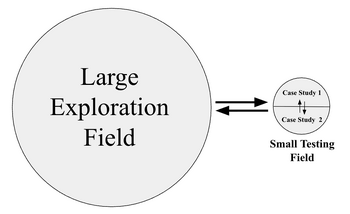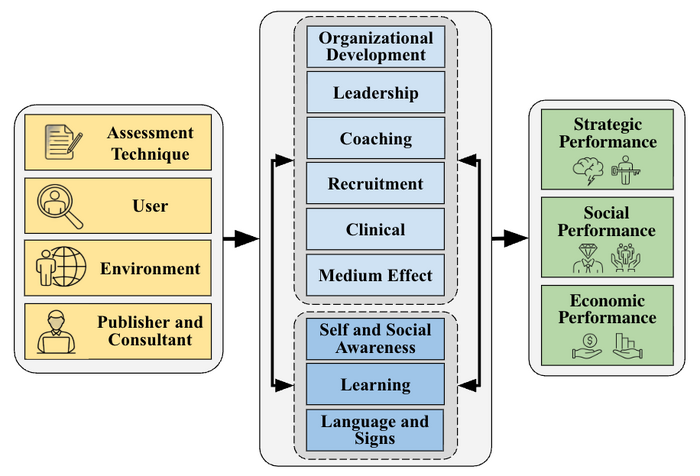General Framework
Introduction
This article presents the general framework built at GRI to analyze the nature, use, and effect of assessment techniques on an organization's performance. Over the years, we have considered a variety of assessment techniques, including behavioral assessments and parallel techniques that we use ourselves privately, and observed the impact those techniques have on leadership, decision-making, communication, and, ultimately, on individuals and a company's performance.
The general framework was built in three phases over a 20-year period. During that period, we devised the GRI assessment and the adaptive profiles by removing the limiting factors uncovered during the first and second phases of the research. This has allowed us to refine what performance means at the individual and organizational levels and to deploy adaptive profiles to operations for use by individuals in executive positions, in addition to their more classic uses in recruitment, search, coaching, and clinical cases. After a brief history of the framework and its construction in two phases, this article presents and comments on its design and reviews a couple of its aspects.
Initial Framework
The first framework was built from 2002 to 2006, with a thesis demonstrating the positive relationship between leaders' and managers' use of personality assessments and personal and organizational performance. The assessment techniques of the early 2000s were in constant progress. Software packages were providing increasing capabilities for analyzing information and computing statistics. The building of the framework followed social research academic standards, notably those of Miles and Huberman[1], Wacheux[2], and Eisenhardt[3].
A large exploration field consisted of 1,116 people from 501 companies, met from 1995 to 2006. The organizations were from varied industries, different countries, and of different sizes[4]. It allowed the collection of information on the uses of assessment techniques, their users, and their effects. The framework was subsequently tested on two organizations, which are referred to as the case studies of the small testing field. The research process followed the diagram below. The arrows represent the interactions between the different fields.
The observations from the large field were from primary sources: direct observations of companies and their people, and secondary sources: testimony from publishing companies, consultants, journalists, and documents. The interaction between the large and small fields happened once the framework was built. Observations from the small field and between the two case studies stimulated new observations on the large field, and vice versa, by going back and forth between the large and small fields, but only after the testing phase started. The framework was successfully tested on case studies of the small testing field. The concepts, assessment techniques, and theories supporting the framework in psychology, sociology, social interactionism, organizational behavior, leadership, and semiotics (the analysis and philosophy of signs) had been documented[5].
General Framework
The initial framework laid the foundation for the second phase, which lasted from 2006 to 2012. After establishing the first framework, the GRI (Growth Resources Institute) was launched in 2012, offering a new platform for quality assessment and marking the start of the third phase. Personality research firmly confirmed the universality and nature of the factors to be used. The Internet enabled unprecedented levels of data collection, usage, and analysis.
Although observations were saturated after the first framework was created, the rise of coaching, advancements in well-being, and the use of typology assessments created new opportunities for observation. After 2005, major exploration areas became more focused on the U.S. and the Bay Area.
The new general framework included assessment techniques such as parallel techniques, rather than relying solely on personality assessments, as in the first phase. The inclusion of new techniques allowed broader analysis and comparison of assessment techniques. As identified in the first phase, assessment techniques both compete and complement each other. The GRI survey was developed by removing important limitations identified in personality assessment techniques during phases 1 and 2. With an increasing number of assessment techniques that can be built quickly with AI, it has become urgent to demonstrate how those techniques differ, how their differences are reflected in their use, and what different impacts users with different roles could expect from them. The general framework was built to answer those questions.
Framework Representation
The general framework is represented below. It includes variables on the use of assessment techniques (the independent variable) and the individual, publishers, and the environment in which the techniques are used (the antecedent variable).
The framework dependent variable, the organization’s performance, is contingent upon individual performance. The adaptive profiles measure and represent performance at those two levels, and subsequently assess the gap between the strategic intent on group performance and its realization.
Different from the first framework, the number of use categories is now nine rather than six. “Clinical” was added, reflecting the increasing use of assessments by clinicians in the workplace. “Coaching” became a new category by itself. With early techniques and techniques used during large events, the framework needed a category to regroup their use, which was named “Medium.”
Although the first framework discussed the parallel techniques, it didn’t include them. The new framework allows comparisons of various techniques, including new advanced techniques based on statistics, and early ones. Social performance includes a “quiet diversity” index that didn’t exist before. “Environment" includes the company's general politics, which used to be a moderating variable in the first framework. It seemed more appropriate to consider it an antecedent variable.
Notes
- ↑ Miles M.B., Huberman A.M. (2003). Qualitative data analysis; De Boeck University.
- ↑ Wacheux, F. (1996). Méthodes Qualitatives de Recherche en Gestion. Economica.
- ↑ Eisenhardt K. M. (1989). Building Theories from Case Study Research, Academy of Management Review, vol. 14, n° 4, pp. 532-550.
- ↑ See here the details of the large exploration field and small testing field.
- ↑ See here about the theories behind the framework, and here about the operationalizations of the concepts.


